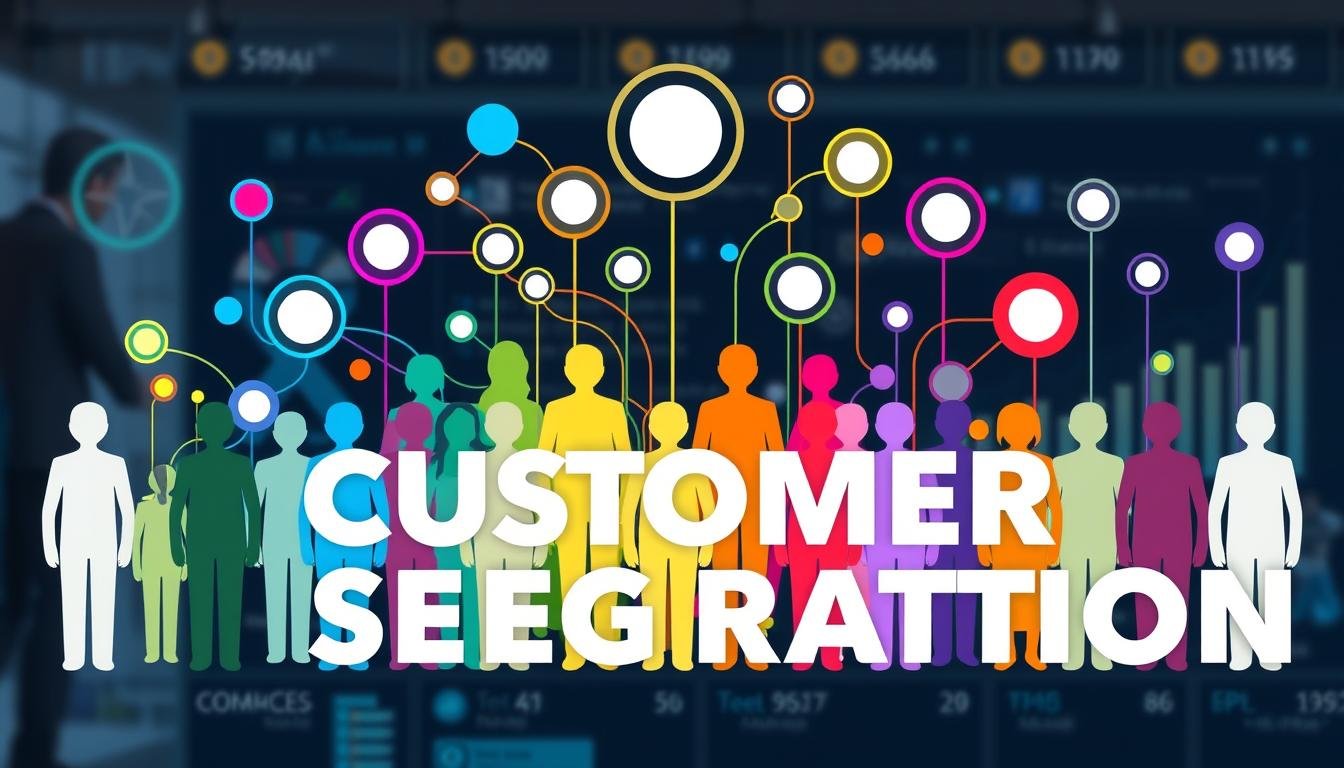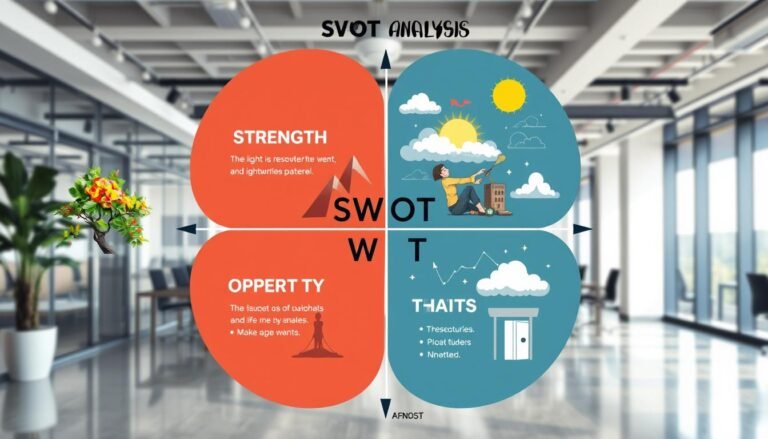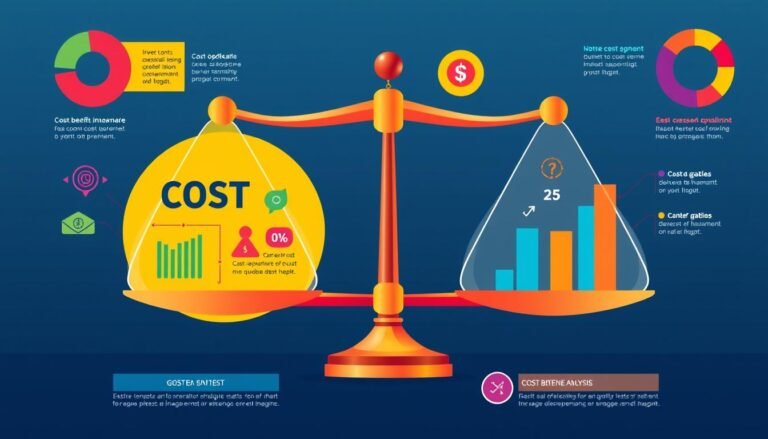Mastering Customer Segmentation Theory Essentials
Is your marketing strategy really reaching your audience, or is it just going unnoticed? Learning about Customer Segmentation Theory can change how you market. This method breaks your market into groups with similar traits, likes, and actions. It helps create strategies that make customers more engaged, happier, and more likely to buy.
Exploring market segmentation shows the importance of both qualitative and quantitative data. They give deep insights into who your customers are. This way, marketers can send messages that really speak to the right people. By getting good at this, your marketing won’t just be seen, but felt by your target groups.
Key Takeaways
- Effective customer segmentation enhances personalization and customization in marketing.
- Understanding your audience helps in maximizing marketing ROI.
- Utilizing various segments, like Active Customers and High-Value Clients, promotes targeted communication.
- Segmenting by behavior and preferences can lead to better engagement and customer retention.
- Leveraging data for audience-based segments increases the effectiveness of marketing strategies.
- Consider geographical location for tailored offers to maximize global reach.
Understanding the Importance of Customer Segmentation
Customer segmentation is key to making marketing strategies work better. It helps businesses understand what different customers like. This way, they can make marketing that speaks directly to each group. This makes customers more engaged and can lead to more sales.
Enhancing Personalization and Customization
Today, people like brands that know them well. In fact, 80% of customers are more likely to buy from companies that send them special deals. By segmenting customers, businesses can send messages that really speak to what each person wants. This makes people more likely to click and buy.
There are different ways to segment customers, like by where they live, what they do, or what their company is like. Each method helps marketers make campaigns that hit the mark with certain groups.
Maximizing Marketing ROI
Getting the most from marketing is a big goal for businesses. Segmentation helps find the customers who are most valuable. This way, companies can use their resources where they count the most.
Using the 80/20 rule, businesses often find that a small group of customers brings in a lot of money. By segmenting customers, they can focus on these key groups. This makes their marketing more effective.
Improving Customer Retention and Loyalty
Segmenting customers also helps keep them coming back. By understanding what different groups want, companies can make experiences that keep customers loyal. This means customers are more likely to stay with the brand.
By focusing on the customers most likely to spend more and be loyal, businesses can build strong relationships. This not only keeps customers around but also gets them talking about the brand. Word of mouth can be a powerful way to bring in new customers.
| Segmentation Type | Focus Areas | Benefits |
|---|---|---|
| Geographic | Climate, population density, cultural differences | Tailored regional marketing strategies |
| Behavioral | Purchase behavior, engagement levels | Higher conversion rates through personalized offers |
| Firmographic | Industry, company size, location | Targeted messages that resonate with specific business needs |
| Technographic | Technology usage, software applications | Enhanced targeting based on tech preferences |
A Comprehensive Overview of Customer Segmentation
Customer segmentation is key to understanding different consumer needs and behaviors. It helps businesses make personalized experiences, improve strategies, and boost engagement. By focusing on specific groups, brands can connect better with their audience and make marketing more effective.
Importance of Customer Segmentation
Customer segmentation is very important. Most customers like personal experiences. Not understanding what customers need can risk losing 9.5% of revenue.
Effective segmentation leads to more customer loyalty and stronger business interactions. Tailored marketing efforts increase engagement and revenue.
Types of Customer Segmentation
There are several ways to segment customers:
- Demographic segmentation: This method looks at age, gender, income, and education. It helps understand consumer groups and their buying habits.
- Psycho graphic segmentation: This focuses on customers’ lifestyles, interests, and values. It helps brands connect on an emotional level by matching products with customer desires.
- Behavioral segmentation: This looks at how customers buy, their loyalty, and how engaged they are. It helps create strategies for specific behaviors, keeping customers coming back.
Using these segmentation methods can greatly benefit businesses. For example, Mailchimp saw a 14.31% increase in email open rates and 100.95% more clicks with segmented campaigns. This shows the power of targeted marketing.
DigitalOcean also saw a 33% better cost per conversion by understanding their audience. Recognizing the unique needs of your audience is crucial in today’s market.
Key Steps for Effective Segmentation
Starting with a clear focus on the right data points is key to effective segmentation. This means looking closely at what customers like and how they behave. By focusing on these details, companies can make their strategies better match what their customers need.
Identifying Relevant Data Points
Finding the right data points is vital for a good segmentation plan. Knowing things like customer age, where they live, and what they like to buy gives a full picture of who they are. For example, knowing someone’s age or where they live helps marketers target them better. Knowing what they’re interested in and what matters to them gives even more insight into why they buy things.
It’s also important to collect data on what customers buy and how they interact with a brand. This information helps companies understand their customers better. It lets them make their marketing more precise and effective.
Gathering Data
After picking the important data points, the next step is to collect this data from different places. Using tools like CRM systems and web analytics helps get a complete view of customer behavior. This way, companies can see how customers act over time and make their segmentation better.
Regularly checking the data is crucial. It helps keep the customer segments accurate, adapt to new customer likes, and make better segmentation plans. By keeping customer profiles up to date, brands stay relevant and build strong relationships with their customers.
Choosing the Right Segmentation Criteria
Choosing the right criteria for customer profiling is key to success. It’s about knowing what makes customers different. This includes things like age, interests, and what they buy. This knowledge helps companies make marketing that really speaks to people.
Segmentation Variables Overview
Segmentation variables help group customers in meaningful ways. These can be:
- Demographic: Age, gender, income, education level.
- Geographic: Location, climate, urban vs rural settings.
- Psychographic: Lifestyle, values, interests.
- Behavioral: Purchase habits, brand loyalty, product usage.
Knowing these helps companies understand what customers want. This makes marketing more effective.
Defining Clear Segmentation Criteria
It’s important to set clear criteria for segmentation. This turns complex data into actionable plans. For instance, a car brand might see some customers as looking for deals, others as wanting luxury. This helps them make ads that really speak to each group.
| Segmentation Type | Description | Application |
|---|---|---|
| Demographic | Grouping based on age, gender, income level. | Identify trends among various age groups. |
| Geographic | Classifying customers by location. | Tailor campaigns for specific regions. |
| Psychographic | Understanding values and lifestyles. | Customize product offerings to align with customer beliefs. |
| Behavioral | Analyzing purchasing behaviors. | Develop loyalty programs based on purchase history. |
By using these criteria, companies can spot unique needs in the market. This way, they can make sure their marketing hits the mark with their audience.
Bringing Segmentation to Life Through Target Audience Analysis
Effective customer segmentation comes alive through deep target audience analysis. This process is key to making customer personas that really capture different groups. By digging into what drives people to buy, businesses can make their messages hit home.
Creating Distinct Customer Personas
Building customer personas means mixing demographic info with what people think and feel. This gives a fuller picture of who you’re talking to. Companies can sort people by what they believe in, their way of life, and their views. These personas should have details like:
- Age and income level
- Geographic location
- Preferences and lifestyle choices
- Motivations behind purchasing decisions
For example, Patagonia uses deep psychographic insights to speak to those who care about the planet. This approach builds strong bonds with their customers. Knowing customers better helps brands talk to them in a way that feels right, making those relationships stronger.
Testing and Refining Segments
Testing and improving segments means always checking how well your messages land with your audience. This ongoing check is key to staying on point with the market. To make this work, you can:
- Use data on buying habits and what people think.
- Do surveys to hear from customers.
- Look at what drives people to buy.
- Test different approaches with A/B testing.
By focusing on what people think and feel, brands can use their resources better. This way, they make campaigns that really speak to their audience. This ongoing fine-tuning leads to better interactions, more engagement, and higher conversion rates.
Customer Segmentation Theory: From Theory to Action
Moving from theory to action in customer segmentation is key for businesses to boost their marketing. By using different strategies, companies can make their messages and offers more effective. This helps them connect better with each customer group.
Implementing Segmentation Strategies
Companies need to keep checking and changing their strategies as the market changes. About 59% of companies have started big market-segmentation projects in the last two years. Yet, only 14% say these efforts really help them.
Using data like purchase history and brand loyalty is crucial for guessing what customers will do next. It’s also smart for companies to update their segmentation plans as consumer attitudes and needs change.
Case Study Examples
Airbnb is a great example of a company that uses segmentation well. They offer different things to customers based on what they like and how much they can spend. This has made their service better and helped them get more customers.
Another example is a specialized accounting service that focuses on different industries. This approach helps them serve clients better in various sectors. These stories show how a good segmentation strategy can help a business stand out.
Conclusion
Learning about Customer Segmentation Theory is key to making marketing strategies that really work. It helps businesses understand their customers and offer what they need. This way, companies can build strong relationships and meet the unique needs of their customers.
Using both psychographics and demographics is crucial. It helps brands spot market gaps and create products that fit what people want. Banks and insurance companies show how important it is to know what customers like. If customers don’t feel valued, businesses can lose a lot of money.
In today’s competitive world, knowing how to segment customers is vital for success. By applying Customer Segmentation Theory, companies can make their marketing better and change their plans as needed. Those that focus on their customers will do well. They create experiences that connect with people, leading to more loyal customers and more value over time.
Source Links
- Mastering Customer Segmentation for Ecommerce Success
- 8 Companies Mastering Customer Segmentation [+ Examples]
- Customer Segmentation Strategy for Cross-Channel Campaigns | AdRoll
- Customer Segmentation
- Customer Segmentation Analysis: Definition & Methods – Qualtrics
- Customer Segmentation Models: The What, Why & How
- Market Segmentation: Definition, Types, Benefits, & Best Practices
- Market Segmentation Simplified: The 5 Types You Must Know
- Segmentation & Strategy
- The Ultimate Guide to Needs-Based Customer Segmentation
- The ultimate framework for segmenting your customers
- How to identify the best market segments and target audience
- What is Psychographic Segmentation? A Beginner’s Guide
- What Is Audience Segmentation? Top Segmenting Strategies – LeadLander
- Rediscovering Market Segmentation
- Customer Segmentation Models: Types, Benefits & Uses | Marketing Evolution
- Customer segmentation: The concepts of trust, commitment and relationships – Journal of Targeting, Measurement and Analysis for Marketing
- What Is Market Segmentation Theory? Definition and How It Works
- Customer Segmentation Analysis: Definition & Methods







